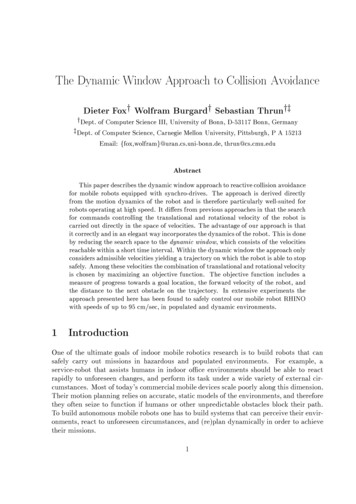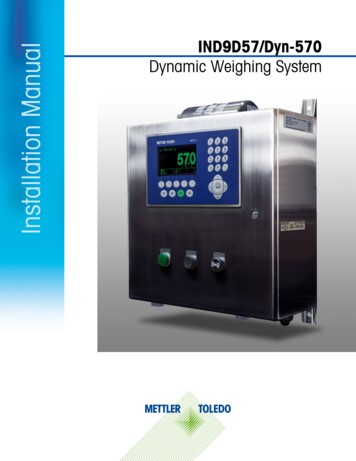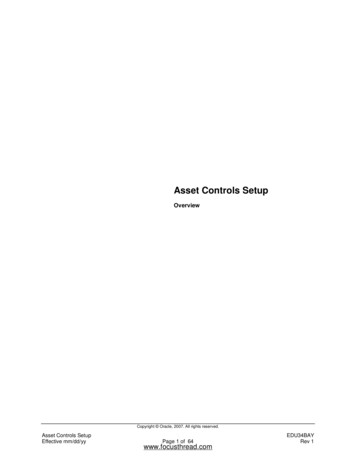
Transcription
The Dynamic Window Approach to Collision AvoidanceDieter Foxy Wolfram Burgardy Sebastian Thrunyzy Dept.of Computer Science III, University of Bonn, D-53117 Bonn, Germanyz Dept. of Computer Science, Carnegie Mellon University, Pittsburgh, P A 15213Email: ffox,wolframg@uran.cs.uni-bonn.de, thrun@cs.cmu.eduAbstractThis paper describes the dynamic window approach to reactive collision avoidancefor mobile robots equipped with synchro-drives. The approach is derived directlyfrom the motion dynamics of the robot and is therefore particularly well-suited forrobots operating at high speed. It di ers from previous approaches in that the searchfor commands controlling the translational and rotational velocity of the robot iscarried out directly in the space of velocities. The advantage of our approach is thatit correctly and in an elegant way incorporates the dynamics of the robot. This is doneby reducing the search space to the dynamic window, which consists of the velocitiesreachable within a short time interval. Within the dynamic window the approach onlyconsiders admissible velocities yielding a trajectory on which the robot is able to stopsafely. Among these velocities the combination of translational and rotational velocityis chosen by maximizing an objective function. The objective function includes ameasure of progress towards a goal location, the forward velocity of the robot, andthe distance to the next obstacle on the trajectory. In extensive experiments theapproach presented here has been found to safely control our mobile robot RHINOwith speeds of up to 95 cm/sec, in populated and dynamic environments.1 IntroductionOne of the ultimate goals of indoor mobile robotics research is to build robots that cansafely carry out missions in hazardous and populated environments. For example, aservice-robot that assists humans in indoor o ce environments should be able to reactrapidly to unforeseen changes, and perform its task under a wide variety of external circumstances. Most of today's commercial mobile devices scale poorly along this dimension.Their motion planning relies on accurate, static models of the environments, and thereforethey often seize to function if humans or other unpredictable obstacles block their path.To build autonomous mobile robots one has to build systems that can perceive their environments, react to unforeseen circumstances, and (re)plan dynamically in order to achievetheir missions.1
This paper focuses on one particular aspect of the design of such a robot: the reactiveavoidance of collisions with obstacles. The dynamic window approach proposed in thispaper is especially designed to deal with the constraints imposed by limited velocitiesand accelerations, because it is derived directly from the motion dynamics of synchrodrive mobile robots. In a nutshell, our approach considers periodically only a short timeinterval when computing the next steering command to avoid the enormous complexity ofthe general motion planning problem. The approximation of trajectories during such a timeinterval by circular curvatures results in a two-dimensional search space of translationaland rotational velocities. This search space is reduced to the admissible velocities allowingthe robot to stop safely. Due to the limited accelerations of the motors a further restrictionis imposed on the velocities: the robot only considers velocities that can be reached withinthe next time interval. These velocities form the dynamic window which is centred aroundthe current velocities of the robot in the velocity space.Among the admissible velocities within the dynamic window the combination of translational and rotational velocity is chosen by maximizing an objective function. The objectivefunction includes a measure of progress towards a goal location, the forward velocity ofthe robot, and the distance to the next obstacle on the trajectory. By combining these,the robot trades o its desire to move fast towards the goal and its desire to ship aroundobstacles (which decrease the free space). The combination of all objectives leads to avery robust and elegant collision avoidance strategy.Figure 1. The robot RHINO, an RWI B21.The dynamic window approach has been implemented and tested using RHINO, aB21 robot manufactured by Real World Interface Inc. (see Figure 1), and other synchrodrive robots. In extensive experimental evaluations using ultrasonic proximity sensors2
for the construction of local world models (obstacle line elds), the method has provento avoid collisions reliably with speeds of up to 95 cm/sec on several robots in severalindoor environments (University of Bonn, Carnegie Mellon University, 1994 AAAI robotcompetition, 1995 IJCAI robot exhibition, and others, see also [3]). The method has alsosuccessfully been operated based on cameras and infrared detectors as sensory input.Our approach di ers from previous approaches in (a) that it is derived directly fromthe motion dynamics of a mobile robot, (b) it therefore takes the inertia of the robotinto account { which is particularly important if a robot with torque limits travels at highspeed {, and (c) has safely controlled several RWI robots in various cluttered and dynamicenvironments with speeds of up to 95 centimeter per second. We envision this approach tobe particularly useful for robots that travel at even higher speeds and for low-cost robotswith limited motor torques, for which the constraints imposed by the motion dynamicsare even more imperative.The remainder of this paper is organized as follows. After discussing related workSection 3 gives the general motion equations for synchro-drive mobile robots. One of thekey results here is that trajectories of synchro-drive robots can be approximated accuratelyby nitely many segments of circles. Section 4 describes our approach, as outlined above.Experimental results are summarized in Section 5, followed by a discussion of furtherresearch issues.2 Related WorkThe collision avoidance approaches for mobile robots can roughly be divided into twocategories: global and local. The global techniques, such as road-map, cell decompositionand potential eld methods (see [10] for an overview and further references), generallyassume that a complete model of the robot's environment is available. The advantage ofglobal approaches lies in the fact that a complete trajectory from the starting point to thetarget point can be computed o -line. However, global approaches are not appropriatefor fast obstacle avoidance. Their strength is global path planning. Additionally, thesemethods have proven problematic when the global world model is inaccurate, or simplynot available, as is typically the case in most populated indoor environments. Hu/Brady,Moravec and others [5, 11], have shown how to update global world models based on sensory input, using probabilistic representations. A second disadvantage of global methodsis their slowness due to the inherent complexity of robot motion planning [12]. This isparticularly problematic if the underlying world model changes on-the- y, because of theresulting need for repeated adjustments of the global plan. In such cases, planning in aglobal model is usually too expensive to be done repeatedly.Local or reactive approaches, on the other hand, use only a small fraction of the worldmodel, to generate robot control. This comes at the obvious disadvantage that they cannotproduce optimal solutions. Local approaches are easily trapped in local minima (such asU-shaped obstacle con gurations). However, the key advantage of local techniques overglobal ones lies in their low computational complexity, which is particularly important3
when the world model is updated frequently based on sensor information. For example,potential eld methods, as proposed by [8], determine the steering direction by (hypothetically) assuming that obstacles assert negative forces on the robot, and that the targetlocation asserts a positive force. These methods are extremely fast, and they typicallyconsider only the small subset of obstacles close to the robot. Borenstein and Koren [9]identi ed that such methods often fail to nd trajectories between closely spaced obstacles;they also can produce oscillatory behavior in narrow corridors. An extended version ofthe potential eld approach is introduced in [7]. By modifying the potential function themotion of the robot becomes more e cient and di erent behaviors such as wall followingand tracking can be achieved.In [2], the vector eld histogram approach is proposed, which extends the previouslydeveloped virtual force eld histogram [1]. This approach uses an occupancy grid representation for modeling the robot's environment, which is generated and updated continuously using ultrasonic proximity sensors. Occupancy information is transformed into ahistogram description of the free space around the robot, which is used to compute themotion direction and velocity for the robot. As noted above, local methods are typicallyvery fast, and they quickly adapt to unforeseen changes in the environment.left wall1mrobotright wall Iright wall IItargetFigure 2. Example situationMost of these local approaches generate motion commands for the robot in two separatestages [1, 2, 8]. In the rst stage a desired motion direction is determined. In the secondstage the steering commands yielding a motion into the desired direction are generated.Strictly speaking, such an approach is only justi able if in nite forces can be assertedon the robot. However, for robots with limited accelerations it is necessary to take intoaccount the impulse of the robot.For example consider the situation given in Figure 2 and suppose that the robot isin a fast straight motion in the corridor while the target point is in the small openingto its right. Obviously, the optimal target direction implies a turn to the right. Withoutrespecting that its forces are not high enough to perform the necessary sharp turn the robotwould collide with the wall (right wall II ). By only considering the admissible velocitiesin the dynamic window our method detects that the robot cannot perform the sharp turn.Thus the robot would stay on its current straight trajectory and not collide with the wall.4
3 Motion Equations for a Synchro-Drive RobotThis section describes the fundamental motion equations for a synchro-drive mobile robot[4]. The derivation begins with the correct dynamic laws, assuming that the robot's translational and rotational velocity can be controlled independently (with limited torques). Tomake the equations more practical, we derive an approximation that models velocity as apiecewise constant function in time. Under this assumption, robot trajectories consist ofsequences of nitely many segments of circles. Such representations are very convenientfor collision checking, since intersections of obstacles with circles are easy to check. Wealso derive an upper bound for the approximation error. The piecewise circular representation forms the basis of the dynamic window approach to collision avoidance, describedin Section 4.3.1 General Motion EquationsLet x(t) and y(t) denote the robot's coordinate at time t in some global coordinate system,and let the robot's orientation (heading direction) be described by (t). The triplet hx; y; idescribes the kinematic con guration of the robot. The motion of a synchro-drive robotis constrained in a way such that the translational velocity v always leads in the steeringdirection of the robot, which is a non-holonomic constraint [10]. Let x(t0) and x(tn)denote the x-coordinates of the robot at time t0 and tn, respectively. Let v(t) denote thetranslational velocity of the robot at time t, and !(t) its rotational velocity. Then x(tn)and y(tn) can be expressed as a function of x(t0), v(t) and (t):x(tn ) x(t0) y (tn ) y (t0) Z tntZ 0tnt0v (t) cos (t) dt(1)v (t) sin (t) dt(2)Equations (1) and (2) depend on the velocities of the robot, which usually cannot beset directly. Instead, the velocity v(t) depends on the initial translational velocity v(t0)at t0, and the translational acceleration v (t ) in the time interval t 2 [t0; t]. Likewise, theorientation (t) is a function of the initial orientation (t0), the initial rotational velocity! (t0) at t0, and the rotational acceleration ! (t ) with t 2 [t0; t]. Substituting v (t) and (t)by the corresponding initial kinematic and dynamic con guration v(t0); (t0); !(t0) andthe accelerations v (t ) and ! (t ) yields the expression1 :x(tn ) x(t0) Z tn t0v (t0) Ztt0 v (t ) dt cos (t0) Z t Z t t0t0! (t0 ) ! (t ) dt dt dt (3)The equations are now in the form that the trajectory of the robot depends exclusivelyon its initial dynamic con guration at time t0 and the accelerations, which we assume1 Notice that the derivation of y(t ) is analogous, thus we only describe the derivation for the xncoordinate.5
to be controllable (for most mobile robots the accelerations determining its motion aremonotonic functions of the currents owing through the motors [6]. Hence, limits on thecurrents directly correspond to limits on the accelerations).Digital hardware imposes constraints as to when one can set the motor currents (andthus set new accelerations). Hence, Eq. (3) can be simpli ed by assuming that betweentwo arbitrary points in time, t0 and tn, the robot can only be controlled by nitely manyacceleration commands. Let n denote this number of time ticks. Then, the accelerations v iand ! i for i 1 : : : n are kept constant in a time interval [ti; ti 1] (i 1 : : : n). Let it and i t be de ned as it t , ti and i t t , ti for some interval index i 1 : : : n. Using thisdiscrete form, the dynamic behavior of a synchro-drive robot is expressed by the followingequation, which follows directly from Eq. (3) under the assumption of piecewise constantaccelerations: nX,1 Z t 1 1x(tn ) x(t0) v (ti) v i it cos (ti ) ! (ti ) it ! i ( it )2 dt(4)2i 0 tii3.2 Approximate Motion EquationsWhile Eq. (4) describes the general case of mobile root control, it is not particularly helpfulwhen determining the actual steering direction. This is because the trajectories generatedby these equations are complex, and geometric operations such as checks for intersectionsare expensive to perform.To derive a more practical model, we will now simplify Eq. (4) by approximating therobot's velocities within a time interval [ti; ti 1] by a constant value. The resulting motionequation, Eq. (6), converges to Eq. (4) as the length of the time intervals goes to zero.As we will see under this assumption the trajectory of a robot can be approximated bypiecewise circular arcs. This representation is well-suited for generating motion control inreal time, as described in Section 4If the time intervals [ti; ti 1] are su ciently small, the term v(ti) v i it can be approximated by an arbitrary translational velocity vi 2 [v(ti); v(ti 1)], due to the smoothness ofrobot motion in time. Likewise, the term (ti) !(ti) 12 ! i( it)2 can be approximated byan arbitrary (ti) !i it, where !i 2 [!(ti); !(ti 1)]. This leads to the following motionequationx(tn ) x(t0) nX,1 Z ti 1i 0tivi cos ( (ti) !i (t , ti )) dt (5)which, by solving the integral, can be simpli ed tox(tn ) x(t0) whereFxi (t) nX,1i 0(Fxi(ti 1))(6)( vi(sin (t ) , sin( (t ) !i!ivi cos( (ti ))i t; !i 0i (t , ti))); !i 6 06(7)
The corresponding equations for the y-coordinate are:y (tn ) y (t0) Fyi(t) (nX,1i 0(Fyi(ti 1))(8), !v (cos (ti) , cos( (ti) !i (t , ti))); !i 6 0vi sin( (ti)) t; !i 0ii(9)Notice that if !i 0, the robot will follow a straight line. Conversely, if !i 6 0, therobot's trajectory describes a circle, as can be seen by consideringvMxi , i sin (ti )(10)!Myii !vi cos (ti)i(11)for which the following relation holds: 2 2 2viFxi , Mxi Fyi , Myi (12)!iThis shows that the i-th trajectory is a circle Mi about (Mxi ,Myi ) with radius Mri !v .Hence, by assuming piecewise constant velocities, we can approximate the trajectory of arobot by a sequence of circular and straight line arcs.Notice that, apart from the initial conditions, Equations (5) to (9) depend only onvelocities. When controlling the robot, however, one is not free to set arbitrary velocities,since the dynamic constraints of the robot impose bounds on the maximum deviation ofvelocity values in subsequent intervals.ii3.3 An Upper Bound on the Approximation ErrorObviously, the derivation makes the approximate assumption that velocities are piecewiseconstant within a time interval. This error is bounded linearly in time between controlpoints, ti 1 , ti a fact which will be used below for modeling uncertainty in the robot'sposition.Consider the errors Exi and Eyi for the x- and y-coordinate, respectively, within the timeinterval [ti; ti 1]. Let ti : ti 1 ,ti. The deviation in the direction of any of the two axes ismaximal if the robot moves on a straight trajectory parallel to that axis. Since in each timeinterval we approximate v(t) by an arbitrary velocity vi 2 [v(ti); v(ti 1)], an upper bound ofthe errors Exi and Eyi for (i 1)-th time interval is governed by Exi ; Eyi jv(ti 1),v(ti)j ti,which is linear in ti.The reader should notice that this bound applies only to the internal prediction of therobot's position. When executing control, the location of the robot is measured periodicallywith its wheel-encoders (four times a second in our implementation).This completes the derivation of the robot motion. To summarise, we have derivedan approximate form that describes trajectories by sequences of circular arcs, and wehave derived a linear bound on the error due to an approximate assumption made in thederivation (piecewise constant velocities).7
4 The Dynamic Window ApproachIn the dynamic window approach the search for commands controling the robot is carriedout directly in the space of velocities. The dynamics of the robot is incorporated intothe method by reducing the search space to those velocities which are reachable under thedynamic constraints. In addition to this restriction only velocities are considered whichare safe with respect to the obstacles. This pruning of the search space is done in the rststep of the algorithm. In the second step the velocity maximizing the objective function ischosen from the remaining velocities. A brief outline of the di erent parts of one cycle ofthe algorithm is given in Figure 3. In the current implementation such a cycle is performedevery 0.25 seconds.In the remainder of this section we will use the situation shown in Figure 2 to describethe di erent aspects of the dynamic window approach.4.1 Search SpaceCircular trajectoriesIn Section 3 we showed that it is possible to approximate the trajectory of a synchrodrive robot by a sequence of circular arcs. In the remainder of this paper we will refer tothese circles as curvatures. Each curvature is uniquely determined by the velocity vector(vi, !i ), which we will simply refer as velocity. To generate a trajectory to a given goalpoint for the next n time intervals the robot has to determine velocities (vi, !i), one foreach of the n intervals between t0 and tn. This has to be done under the premise thatthe resulting trajectory does not intersect with an obstacle. The search space for thesevectors is exponential in the number of the considered intervals.To make the optimization feasible, the dynamic window approach considers exclusivelythe rst time interval, and assumes that the velocities in the remaining n , 1 time intervalsare constant (which is equivalent to assuming zero accelerations in [t1; tn]). This reductionis motivated by the observations that (a) the reduced search space is two-dimensional andthus tractable, (b) the search is repeated after each time interval, and (c) the velocitieswill automatically stay constant if no new commands are given.Admissible VelocitiesObstacles in the closer environment of the robot impose restrictions on the rotational andtranslational velocities. For example, the maximal admissible speed on a curvature depends on the distance to the next obstacle on this curvature. Assume that for a velocity(v; !) the term dist(v; !) represents the distance to the closest obstacle on the corresponding curvature (in Section 5.2 we describe how to compute this distance given circulartrajectories). A velocity is considered admissible, if the robot is able to stop before itreaches this obstacle. Let v b and ! b be the accelerations for breakage. Then the set Va of8
1. Search space: The search space of the possible velocities is reduced inthree steps:(a) Circular trajectories: The dynamic window approach considersonly circular trajectories (curvatures) uniquely determined by pairs(v; !) of translational and rotational velocities. This results in atwo-dimensional velocity search space.(b) Admissible velocities: The restriction to admissible velocitiesensures that only safe trajectories are considered. A pair (v; !) isconsidered admissible, if the robot is able to stop before it reachesthe closest obstacle on the corresponding curvature.(c) Dynamic window: The dynamic window restricts the admissiblevelocities to those that can be reached within a short time intervalgiven the limited accelerations of the robot.2. Optimization: The objective functionG(v; ! ) ( heading(v; ! ) dist(v; ! ) vel(v; ! ))(13)is maximized. With respect to the current position and orientation of therobot this function trades o the following aspects:(a) Target heading: heading is a measure of progress towards thegoal location. It is maximal if the robot moves directly towards thetarget.(b) Clearance: dist is the distance to the closest obstacle on the trajectory. The smaller the distance to an obstacle the higher is therobot's desire to move around it.(c) Velocity: vel is the forward velocity of the robot and supports fastmovements.The function smoothes the weighted sum of the three components andresults in more side-clearance from obstacles.Figure 3: Di erent parts of the dynamic window approachadmissible velocities is de ned as qVa (v; ! ) j v 2 dist(v; ! ) v bq ! 2 dist(v; !) ! b :(14)Thus Va is the set of velocities (v; !) which allow the robot to stop without colliding withan obstacle.9
Vs90 cm/secleft wallcorridorright wall IIdoorright wall IVa-90 deg/secFigure 4. Velocity space90 deg/secExample 1 Again consider the example given in Figure 2. Figure 4 shows the velocitiesadmissible in this situation given the accelerations v b 50 cm/sec2 and ! b 60 deg/sec2.The non-admissible velocities are denoted by the dark shaded areas. For example allvelocities in area right wall II would cause a sharp turn to the right and thus cause therobot to collide with the right wall in the example situation. The non-admissible areas areextracted from real world proximity information; in this special case this information wasobtained from sonar sensors (see Section 5).Dynamic windowIn order to take into account the limited accelerations exertable by the motors the overallsearch space is reduced to the dynamic window which contains only the velocities thatcan be reached within the next time interval. Let t be the time interval during which theaccelerations v and ! will be applied and let (va, !a) be the actual velocity. Then thedynamic window Vd is de ned asVd f(v; ! ) j v [va , v t; va v t] ! [!a , ! t; !a ! t]g :(15)The dynamic window is centred around the actual velocity and the extensions of it dependon the accelerations that can be exerted. All curvatures outside the dynamic windowcannot be reached within the next time interval and thus are not considered for the obstacleavoidance.Example 2 An exemplary dynamic window obtained in the situation shown in Figure 2given accelerations of 50 cm/sec2 and 60 deg/sec2 and a time interval of 0.25 sec is shownin Figure 5. The two dotted arrows pointing to the corners of the rectangle denote themost extreme curvatures that can be reached.10
Vs90 cm/secdynamic window VdVractual velocityVa-90 deg/secFigure 5. Dynamic window90 deg/secResulting Search SpaceThe above given restrictions imposed on the search space for the velocities result in thearea Vr within the dynamic window. Let Vs be the space of possible velocities, then thearea Vr is de ned as the intersection of the restricted areas, namelyVr Vs \ Va \ Vd(16)In Figure 5 the resulting search space is represented by the white area.4.2 Maximizing the Objective FunctionAfter having determined the resulting search space Vr a velocity is selected from Vr . Inorder to incorporate the criteria target heading, clearance, and velocity, the maximum ofthe objective functionG(v; ! ) ( heading(v; ! ) dist(v; ! ) velocity(v; ! ))is computed over Vr . This is done by discretization of the resulting search space.Target headingThe target heading heading(v; !) measures the alignment of the robot with the target direction. It is given by 180 , , where is the angle of the target point relative to the robot'sheading direction (see Figure 6). Since this direction changes with the di erent velocities, is computed for a predicted position of the robot. To determine the predicted positionwe assume that the robot moves with the selected velocity during the next time interval.For a realistic measurement of the target heading we have to consider the dynamics ofthe rotation. Therefore, is computed at the position, which the robot will reach when11
targettargt headingθ10.5900predicted position60trans. velocity [cm/sec]30-90-450rot. velocity [deg/sec] 450actual positionFigure 6. Angle to theFigure 7. Evaluation of the targettargetheadingexerting maximal deceleration after the next interval. This yields a smooth turning to thetarget in the behavior of the robot when it has circumvented an obstacle.Example 3 Figure 7 shows the evaluation of the target heading for the di erent velocitiesin the example situation. In this gure and the following gures the values for nonadmissible velocities are set to zero (compare with Figures 2 and 4). For clarity we showthe evaluation of the whole velocity space and do not restrict it to the dynamic window.The non-linearity of the function in Figure 7 is caused by the consideration of the dynamicsin the determination of the predicted position. Because positive rotational velocities yieldcurvatures to the right we nd the best velocities on the right side of the velocity space.The optimal velocities are those leading to a perfect heading to the target on the predictedposition. The function declines for even higher rotational velocities, because they yield aturning beyond the target.ClearanceThe function dist(v; !) represents the distance to the closest obstacle that intersects withthe curvature. If no obstacle is on the curvature this value is set to a large constant.distancevelocity110.50.5900-90-450rot. velocity [deg/sec] 4590060trans. velocity [cm/sec]3060trans. velocity [cm/sec]30-90-450rot. velocity [deg/sec] 450Figure 8. Evaluation of thedistances0Figure 9. Evaluation of thevelocities12
Example 4 The evaluation of the distances as given in Figure 8 solely depends on theproximity information about obstacles around the robot. In the given plot one can nd lowevaluations for those curvatures which lead to the walls. For higher translational velocitiesthese values fall into the non-admissible areas and are thus set to zero.VelocityThe function velocity(v; !) is used to evaluate the progress of the robot on the corresponding trajectory. It is simply a projection on the translational velocity v, as can be seen inFigure 9.Smoothingevaluation functionsmoothed evaluation function32211900-90-450rot. velocity [deg/sec] 4590060trans. velocity [cm/sec]3060trans. velocity [cm/sec]30-90-450rot. velocity [deg/sec] 4500Figure 10. Combined evaluationFigure 11. Objective functionfunctionAll three components of the objective function are normalized to [0; 1]. The weighted sumof these components is shown in Figure 10. It is obtained by a value of 2.0 for and avalue of 0.2 for and . As expected the fastest trajectory leading through the door areagets the highest evaluation (compare with Figure 4). Smoothing increases side-clearanceof the robot. The resulting objective function is shown in Figure 11 and the position ofthe maximal value is depicted by the vertical line.It should be noticed that all three components of G, the target heading, the clearanceand the velocity are necessary. By maximizing solely the clearance and the velocity, therobot would always travel into free space but there would be no incentive to move towardsa goal location. By solely maximizing the target heading the robot quickly would getstopped by the rst obstacle that blocks its way, unable to move around it. By combiningall three components, the robot circumvents collisions as fast as it can under the constraintslisted above, while still making progress towards reaching its goal.In a former version of our approach (see [3]) the search for the best velocity wascarried out in two steps. In the rst step only the curvature was chosen. This was done byevaluating the target angle and the so-called \n-sec-rule", namely a linear function of theclearance. In the second step the velocity on this curvature was maximized. Although the13
resulting behavior of the robot was the same, we decided to use this single step evaluationof the objective function. We adopted the idea for this representation from [13].4.3 Role of the dynamic windowIn the previous section we introduced the objective function to be maximized for smoothand goal directed behavior. For illustration purposes we always showed the evaluationfor the whole velocity space. As mentioned in Section 4.1 this space is reduced to theadmissible velocities in the dynamic window. I
eir pa h. T o build a u t onomous mobile rob ot son eh as t o build syst ems t h a t can p erce iv et eir en vir-onm en t s, re act t ou nfore s een circu mst ance s, an d (re)p lan dyn amically in ord . ed w or k Sect ion 3 giv es t h e gen eral mot ion equa t ions for sync hro-dr iv e mobile rob ot s. On eof t e k ey re sul t sh










